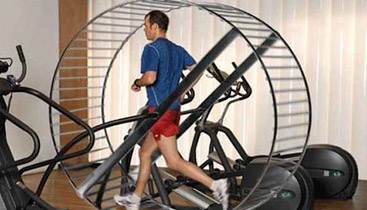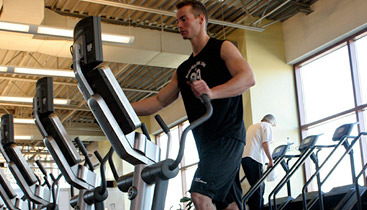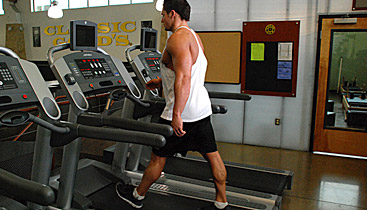9 COMMON CARDIO MISTAKES AND HOW TO AVOID THEM

Just because you’ve decided to include some cardio in your fitness program doesn’t necessarily mean you’re performing it as effectively or as efficiently as you could be.
And with all the conflicting fat loss information circulating out there on the web these days, the subject of proper cardio can be a confusing one.
Exactly how much cardio should you be doing? What are the best cardio exercises? When is the best time to do it? How intensely should you perform it?
In today’s post I outline 9 of the most common cardio mistakes that most typical trainees make, and how to avoid them for the very best results…
Cardio Mistake #1
Not performing any cardio at all.

While cardio isn’t an absolute “must” in order to lose fat and stay lean (since this can technically be achieved through dieting alone), performing some cardio throughout the week is still a good idea for the overall physical and mental benefits it provides.
The human body evolved to move, and remaining stationary for extended periods of time (especially in a seated position) is not natural to our physiology.
Weight training is certainly great for this purpose as well, but usually isn’t enough on its own to fully offset the effects of an otherwise sedentary lifestyle. This is especially true if you’re following a typical hypertrophy style workout using heavier weights and longer rest periods.
Performing regular cardio throughout the week can produce a wide variety of benefits, such as improving cognitive function, increasing levels of mood-boosting neurotransmitters (such as serotonin and norepinephrine), reducing the risk of certain diseases and improving cardiovascular health and conditioning.
In addition, low intensity forms of cardio can directly improve your muscle building and fat burning results by improving recovery in between workouts, increasing insulin sensitivity, boosting sleep quality and burning additional calories to keep your overall energy balance under control.
No, cardio does not burn muscle or decrease your lifting strength as long as it’s done in moderation, and 2-3 sessions per week will be a good guideline for most lifters to obtain the benefits of cardio without going overboard.
Cardio Mistake #2
Performing too much cardio.

On the opposite end of the spectrum are those who treat cardio as the be-all-end-all of fat loss and simply perform too much.
Yes, performing some cardio is a good idea for those who are relatively sedentary outside of weight training, but keep in mind that there is a bell-curve response at play to where adding in more and more cardio during the week eventually becomes counterproductive.
This is because excessive cardio will interfere with recovery in between workouts (especially if you’re doing a higher intensity form), both in terms of creating additional muscle damage and over-stressing the central nervous system.
Not only that, but higher impact forms like sprinting or plyometrics can also place undo stress on your joints and connective tissues over time as well.
Unless you’re specifically training for endurance, there’s just no need to be running on the treadmill 5 or 6 days a week in an attempt to melt off the fat, and doing so will likely cause you more harm than good when it comes to optimizing body composition.
Keep in mind that cardio doesn’t actually burn a huge number of calories on its own, and in most cases it’s best treated as a supplemental fat burning tool with the bulk of your calorie deficit being created through your diet.
Again, 2-3 sessions per week is a reliable starting point for most people, only increasing the amount later on if you’re deeper into a cut and are trying to reach lower levels of body fat that would be difficult to achieve through dieting alone.
Cardio Mistake #3
Forcing yourself to perform types of cardio you hate.

Although the word “cardio” usually conjures up images of gym treadmills and ellipticals for most people, the truth is that any form of reasonably challenging exercise that increases your heart rate and breathing will ultimately burn calories and deliver the benefits that cardio has to offer.
There’s a huge variety of different activities that you could use for this, and there’s no need to force yourself to perform one specific form of cardio if you really can’t stand doing it.
For example, if you dislike the treadmill, don’t run on the treadmill. If you’re not a fan of the stationary bike, don’t ride the stationary bike.
Instead, find the particular cardio machine that is most enjoyable for you, or do what I do and rotate through multiple machines in the same workout for variety.
Or, try something completely different such as jumping rope, hitting a heavy bag, using body weight circuits or doing kettlebell work or barbell complexes.
The other option? Forget about traditional “gym cardio” altogether.
Try playing sports, taking a fitness class, doing outdoor activities, martial arts, fast paced yoga…
There’s really no end to the number of possible cardio exercises available, and if you can find an activity that you truly enjoy (or that you can at least tolerate), you’ll be able to get all the benefits that cardio has to offer while maximizing the chances that you’ll stick to your program long term, and possibly even learning a new skill while you’re at it.
Cardio Mistake #4
Performing excessive cardio on top of an already active lifestyle.

If you already live a fairly active lifestyle outside of weight training (such as playing sports, riding your bike, doing large amounts of walking, working a physically strenuous job etc.), there’s no need to dump a bunch of extra gym cardio on top of that.
Not only will it be unnecessary from a basic health and fat loss perspective, but it may also directly impact your ability to build muscle and gain strength optimally by over-stressing your body and interfering with recovery.
There’s nothing particularly “special” about performing your cardio using gym equipment (aside from the one benefit of being able to track your speed/resistance levels with a high degree of accuracy), and if you’re already highly active in addition to your weightlifting workouts, you can either cut back on regular cardio or even eliminate it altogether.
Cardio Mistake #5
Doing your cardio immediately pre-workout.

If we’re just talking about something light and easy such as riding your bike to the gym or performing some slow pace cardio as a warmup, then that shouldn’t be an issue.
However, if your goal is to optimize body composition by building muscle and gaining strength at your full potential, weight training should always be treated as the number one priority.
The primary underlying factor when it comes to maximizing muscle growth is to strive for progressive overload by training with a sufficiently high level of intensity and increasing the amount of weight lifted on your exercises over time.
For that reason, you always want to enter your weight training workout with your full physical strength and mental focus intact, rather than pre-fatiguing yourself first by performing cardio.
This is especially true if the type of cardio you’re performing utilizes the actual muscle groups that you’ll be training during your workout, and even moreso if it’s a high intensity form.
In an ideal world you’d separate your weight training and cardio onto different days of the week (or at least space them apart during the day), however, if you do want to combine them for efficiency sake, always perform your cardio post workout.
Cardio Mistake #6
Over-emphasizing HIIT cardio.

This is similar to cardio mistake #2 of performing too much cardio in general, but high intensity interval-based cardio gets a special mention due to its much more highly stressful nature in comparison to lower intensity forms.
HIIT cardio is a very efficient form of exercise since you can burn a higher number of calories in a much shorter time, but this comes at a price. Namely, greater overall muscle damage and increased central nervous system stress.
If you’re already performing a full weight training routine by hitting the gym 3-4 days per week or more, there’s only so much HIIT cardio you can add on top of that before you begin overtraining yourself.
2 HIIT cardio sessions per week is what I’d consider the upper limit for most people (assuming they’re following an intensive weight training plan and are aiming to maximize muscle growth), with the rest of your cardio being made up of the lower intensity variety.
Cardio Mistake #7
Not performing cardio intensely enough.

This is the opposite of the previous cardio mistake, which is to just casually saunter through your workout without any real focused effort at all.
Keep in mind that even if you are going to be doing a lower intensity/longer duration form of cardio, it still needs to be at least somewhat challenging if you want to get a measurable benefit from it.
Don’t be that person at the gym riding the stationary bike or elliptical at a snail pace while texting on their phone and without even remotely breaking a sweat…
If your cardio pace is too slow, you’re honestly just wasting your time for the most part.
If 10 represented a 100% all out effort, then a low intensity cardio session should still fall somewhere around a 5 or 6.
Your heart rate should be up, you should be breathing more heavily, and it should still require you to remain focused on the task at hand rather than just aimlessly going through the motions.
Cardio Mistake #8
Using cardio as an excuse to over-eat.

It happens all the time…
Bob finishes his cardio session, works up a good sweat and is feeling great, and then thinks that since he trained hard and burned some calories, it’s now okay to go ahead and eat whatever he wants without worry and still get into great shape.
The truth is that a typical cardio session doesn’t actually burn that many calories on its own, and since it also stimulates your appetite, it’s very easy to simply replace the calories you burned from your session by over-eating in the hours after.
Fail to control your calorie intake after the cardio is over and you may end up completely negating its fat burning benefits, or in more extreme cases it could even cause you to gain additional weight.
For example, let’s say you performed cardio 3 days a week and burned 400 calories per session. That would represent 1200 calories burned for the week as a whole.
However, if you then go ahead and eat an extra 200 calories per day (which is quite a small amount and very easy to do), by the end of the week you would have burned 1200 calories from your cardio sessions but would have also consumed an additional 1400 calories.
The result would actually be a net gain of 200 calories per week.
No matter what anyone tells you, the primary factor when it comes to leaning down and losing body fat is your overall calorie balance in the big picture.
In other words, you need to maintain a calorie deficit by consistently burning more calories than you consume.
If you’re burning calories through cardio but then continue eating based purely on instinct without tracking anything, you’ll usually just end up replacing what you burned without even realizing it as the body naturally seeks to match its calorie intake to its calorie expenditure.
This is why it’s so common to see people in the gym who perform huge amounts of cardio week in and week out but their bodies never really change.
If you’re performing cardio purely for overall physical and mental health reasons (or for improving cardiovascular conditioning) then that’s a different story.
But if you’re using cardio as a tool for losing body fat like most people are, then this is something you need to be conscious of.
Remember, it doesn’t matter how “healthy” you eat; if you don’t have an ongoing calorie deficit in place, you’re not going to make any significant fat burning progress, period.
Cardio Mistake #9
Believing that fasted cardio burns more fat.

There’s nothing technically wrong with performing cardio on an empty stomach (though I wouldn’t consider it 100% optimal for preserving lean mass on a cut), but don’t fall for the idea that it’s going to produce some sort of “magical” fat burning benefit above and beyond having a small meal first.
Fasted cardio does increase lipolysis (the amount of fat that is broken down), but doesn’t increase fat oxidation (the amount of fat that actually gets burned).
In other words, fasted cardio causes your body to break down more fat than it can actually use for energy. And when it comes to fat loss, the limiting factor is fat oxidation and NOT lipolysis.
In the end, the fatty acids that aren’t used for fuel are simply re-stored as body fat.
In addition, getting in some protein and carbs within a few hours of your cardio session actually has certain potential benefits, such as improving your training performance and helping to minimize the chances of muscle loss.
If you really enjoy performing cardio in a fasted state and feel better that way, then all in all I’d say that’s fine.
However, if you’d prefer to eat first, then there’s no good reason to force yourself to perform your cardio fasted since it likely won’t improve fat loss in the first place.
If you found this article helpful, make sure to sign up for your FREE custom fitness plan below...




